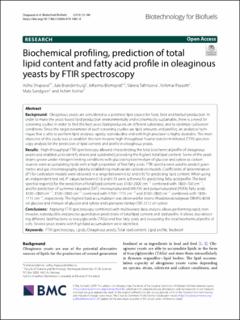| dc.contributor.author | Shapaval, Volha | |
| dc.contributor.author | Brandenburg, Julie | |
| dc.contributor.author | Blomqvist, Johanna Karin Hillevi | |
| dc.contributor.author | Tafintseva, Valeria | |
| dc.contributor.author | Volkmar, Passoth | |
| dc.contributor.author | Mats, Sandgren | |
| dc.contributor.author | Kohler, Achim | |
| dc.date.accessioned | 2020-11-05T13:19:27Z | |
| dc.date.available | 2020-11-05T13:19:27Z | |
| dc.date.created | 2019-11-25T15:16:58Z | |
| dc.date.issued | 2019 | |
| dc.identifier.citation | Biotechnology for Biofuels. 2019, 12 (140), 1-12. | en_US |
| dc.identifier.issn | 1754-6834 | |
| dc.identifier.uri | https://hdl.handle.net/11250/2686597 | |
| dc.description.abstract | Background: Oleaginous yeasts are considered as a potential lipid source for food, feed and biofuel production. In order to make the yeast-based lipid production environmentally and economically sustainable, there is a need for screening studies in order to find the best yeast lipid producers on different substrates, and to optimize cultivation conditions. Since the target parameter of such screening studies are lipid amounts and profiles, an analytical technique that is able to perform lipid analyses rapidly, reproducible and with high precision is highly desirable. The main objective of this study was to establish the non-invasive high-throughput Fourier transform infrared (FTIR) spectroscopy analysis for the prediction of lipid content and profile in oleaginous yeasts. Results: High-throughput FTIR spectroscopy allowed characterizing the total biochemical profile of oleaginous yeasts and enabled us to identify strains and substrate(s) providing the highest total lipid content. Some of the yeast strains grown under nitrogen-limiting conditions with glucose/xylose/mixture of glucose and xylose as carbon sources were accumulating lipids with a high proportion of free fatty acids. FTIR spectra were used to predict gravimetric and gas chromatography data by establishing multivariate calibration models. Coefficients of determination (R2) for calibration models were obtained in a range between 0.62 and 0.92 for predicting lipid content. When using an independent test set, R2 values between 0.53 and 0.79 were achieved for predicting fatty acid profile. The best spectral region(s) for the prediction of total lipid content was 3100–2800 cm−1 combined with 1800–700 cm−1, and for prediction of summed saturated (SAT), monounsaturated (MUFA) and polyunsaturated (PUFA) fatty acids: 3100–2800 cm−1, 3100–2800 cm−1 combined with 1700–1715 cm−1 and 3100–2800 cm−1 combined with 1800– 1715 cm−1, respectively. The highest lipid accumulation was observed for strains Rhodotorula babjevae DBVPG 8058 on glucose and mixture of glucose and xylose and Lipomyces starkeyi CBS 2512 on xylose. Conclusions: Applying FTIR spectroscopy combined with multivariate data analysis allows performing rapid, noninvasive, reproducible and precise quantitative predictions of total lipid content and lipid profile. It allows also detecting different lipid fractions as triacylglycerols (TAGs) and free fatty acids and evaluating the total biochemical profile of cells. Several yeast strains with high lipid accumulation were identified. | en_US |
| dc.language.iso | eng | en_US |
| dc.rights | Navngivelse 4.0 Internasjonal | * |
| dc.rights.uri | http://creativecommons.org/licenses/by/4.0/deed.no | * |
| dc.title | Biochemical profiling, prediction of total lipid content and fatty acid profile in oleaginous yeasts by FTIR spectroscopy | en_US |
| dc.type | Peer reviewed | en_US |
| dc.type | Journal article | en_US |
| dc.description.version | publishedVersion | en_US |
| dc.source.pagenumber | 1-12 | en_US |
| dc.source.volume | 12 | en_US |
| dc.source.journal | Biotechnology for Biofuels | en_US |
| dc.source.issue | 140 | en_US |
| dc.identifier.doi | 10.1186/s13068-019-1481-0 | |
| dc.identifier.cristin | 1752008 | |
| cristin.unitcode | 192,15,5,0 | |
| cristin.unitcode | 192,15,6,0 | |
| cristin.unitname | Seksjon for maskin, prosess og produktutvikling | |
| cristin.unitname | Seksjon for realfag og teknologi | |
| cristin.ispublished | true | |
| cristin.qualitycode | 1 | |

